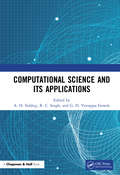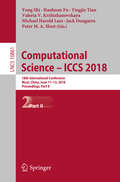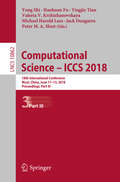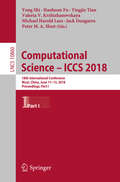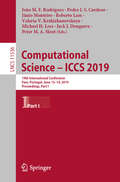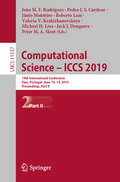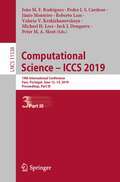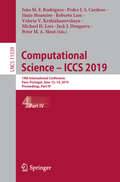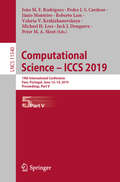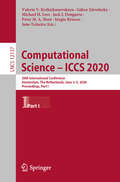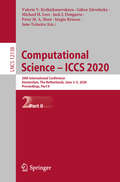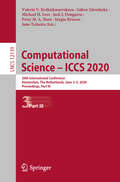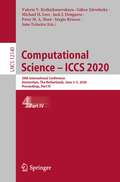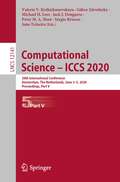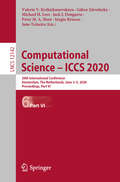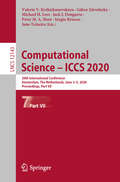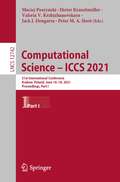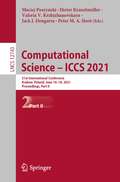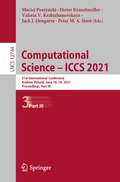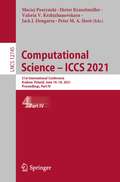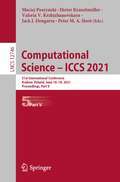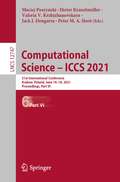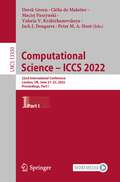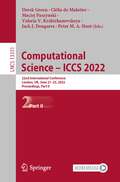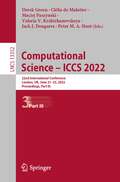- Table View
- List View
Computational Science and its Applications
by A. H. Siddiqi, R. C. Singh, G. D. Veerappa GowdaComputational science is a rapidly growing multidisciplinary field concerned with the design, implementation, and use of mathematical models to analyze and solve real-world problems. It is an area of science that spans many disciplines and which involves the development of models and allows the use of computers to perform simulations or numerical analysis to understand problems that are computational and theoretical. Computational Science and its Applications provides an opportunity for readers to develop abilities to pose and solve problems that combine insights from one or more disciplines from the natural sciences with mathematical tools and computational skills. This requires a unique combination of applied and theoretical knowledge and skills. The topics covered in this edited book are applications of wavelet and fractals, modeling by partial differential equations on flat structure as well as on graphs and networks, computational linguistics, prediction of natural calamities and diseases like epilepsy seizure, heart attack, stroke, biometrics, modeling through inverse problems, interdisciplinary topics of physics, mathematics, and medical science, and modeling of terrorist attacks and human behavior. The focus of this book is not to educate computer specialists, but to provide readers with a solid understanding of basic science as well as an integrated knowledge on how to use essential methods from computational science. Features: Modeling of complex systems Cognitive computing systems for real-world problems Presentation of inverse problems in medical science and their numerical solutions Challenging research problems in many areas of computational science This book could be used as a reference book for researchers working in theoretical research as well as those who are doing modeling and simulation in such disciplines as physics, biology, geoscience, and mathematics, and those who have a background in computational science.
Computational Science – ICCS 2018: 18th International Conference, Wuxi, China, June 11-13, 2018, Proceedings, Part II (Lecture Notes in Computer Science #10861)
by Yong Shi Yingjie Tian Jack Dongarra Haohuan Fu Valeria V. Krzhizhanovskaya Michael Harold Lees Peter M. SlootThe three-volume set LNCS 10860, 10861 and 10862 constitutes the proceedings of the 18th International Conference on Computational Science, ICCS 2018, held in Wuxi, China, in June 2018. The total of 155 full and 66 short papers presented in this book set was carefully reviewed and selected from 404 submissions. The papers were organized in topical sections named: Part I: ICCS Main Track Part II: Track of Advances in High-Performance Computational Earth Sciences: Applications and Frameworks; Track of Agent-Based Simulations, Adaptive Algorithms and Solvers; Track of Applications of Matrix Methods in Artificial Intelligence and Machine Learning; Track of Architecture, Languages, Compilation and Hardware Support for Emerging ManYcore Systems; Track of Biomedical and Bioinformatics Challenges for Computer Science; Track of Computational Finance and Business Intelligence; Track of Computational Optimization, Modelling and Simulation; Track of Data, Modeling, and Computation in IoT and Smart Systems; Track of Data-Driven Computational Sciences; Track of Mathematical-Methods-and-Algorithms for Extreme Scale; Track of Multiscale Modelling and Simulation Part III: Track of Simulations of Flow and Transport: Modeling, Algorithms and Computation; Track of Solving Problems with Uncertainties; Track of Teaching Computational Science; Poster Papers
Computational Science – ICCS 2018: 18th International Conference, Wuxi, China, June 11–13, 2018 Proceedings, Part III (Lecture Notes in Computer Science #10862)
by Yong Shi Yingjie Tian Jack Dongarra Haohuan Fu Valeria V. Krzhizhanovskaya Michael Harold Lees Peter M. SlootThe three-volume set LNCS 10860, 10861 and 10862 constitutes the proceedings of the 18th International Conference on Computational Science, ICCS 2018, held in Wuxi, China, in June 2018. The total of 155 full and 66 short papers presented in this book set was carefully reviewed and selected from 404 submissions. The papers were organized in topical sections named: Part I: ICCS Main Track Part II: Track of Advances in High-Performance Computational Earth Sciences: Applications and Frameworks; Track of Agent-Based Simulations, Adaptive Algorithms and Solvers; Track of Applications of Matrix Methods in Artificial Intelligence and Machine Learning; Track of Architecture, Languages, Compilation and Hardware Support for Emerging ManYcore Systems; Track of Biomedical and Bioinformatics Challenges for Computer Science; Track of Computational Finance and Business Intelligence; Track of Computational Optimization, Modelling and Simulation; Track of Data, Modeling, and Computation in IoT and Smart Systems; Track of Data-Driven Computational Sciences; Track of Mathematical-Methods-and-Algorithms for Extreme Scale; Track of Multiscale Modelling and Simulation Part III: Track of Simulations of Flow and Transport: Modeling, Algorithms and Computation; Track of Solving Problems with Uncertainties; Track of Teaching Computational Science; Poster Papers
Computational Science – ICCS 2018: 18th International Conference, Wuxi, China, June 11–13, 2018, Proceedings, Part I (Lecture Notes in Computer Science #10860)
by Yong Shi Yingjie Tian Jack Dongarra Haohuan Fu Valeria V. Krzhizhanovskaya Michael Harold Lees Peter M. SlootThe three-volume set LNCS 10860, 10861 + 10862 constitutes the proceedings of the 18th International Conference on Computational Science, ICCS 2018, held in Wuxi, China, in June 2018. The total of 155 full and 66 short papers presented in this book set was carefully reviewed and selected from 404 submissions. The papers were organized in topical sections named: Part I: ICCS Main Track Part II: Track of Advances in High-Performance Computational Earth Sciences: Applications and Frameworks; Track of Agent-Based Simulations, Adaptive Algorithms and Solvers; Track of Applications of Matrix Methods in Artificial Intelligence and Machine Learning; Track of Architecture, Languages, Compilation and Hardware Support for Emerging ManYcore Systems; Track of Biomedical and Bioinformatics Challenges for Computer Science; Track of Computational Finance and Business Intelligence; Track of Computational Optimization, Modelling and Simulation; Track of Data, Modeling, and Computation in IoT and Smart Systems; Track of Data-Driven Computational Sciences; Track of Mathematical-Methods-and-Algorithms for Extreme Scale; Track of Multiscale Modelling and Simulation Part III: Track of Simulations of Flow and Transport: Modeling, Algorithms and Computation; Track of Solving Problems with Uncertainties; Track of Teaching Computational Science; Poster Papers
Computational Science – ICCS 2019: 19th International Conference, Faro, Portugal, June 12–14, 2019, Proceedings, Part I (Lecture Notes in Computer Science #11536)
by Jânio Monteiro João M. Rodrigues Valeria V. Krzhizhanovskaya Roberto Lam Michael H. Lees Jack J. Dongarra Pedro J. Cardoso Peter M.A. SlootThe five-volume set LNCS 11536, 11537, 11538, 11539, and 11540 constitutes the proceedings of the 19th International Conference on Computational Science, ICCS 2019, held in Faro, Portugal, in June 2019.The total of 65 full papers and 168 workshop papers presented in this book set were carefully reviewed and selected from 573 submissions (228 submissions to the main track and 345 submissions to the workshops). The papers were organized in topical sections named: Part I: ICCS Main Track Part II: ICCS Main Track; Track of Advances in High-Performance Computational Earth Sciences: Applications and Frameworks; Track of Agent-Based Simulations, Adaptive Algorithms and Solvers; Track of Applications of Matrix Methods in Artificial Intelligence and Machine Learning; Track of Architecture, Languages, Compilation and Hardware Support for Emerging and Heterogeneous Systems Part III: Track of Biomedical and Bioinformatics Challenges for Computer Science; Track of Classifier Learning from Difficult Data; Track of Computational Finance and Business Intelligence; Track of Computational Optimization, Modelling and Simulation; Track of Computational Science in IoT and Smart Systems Part IV: Track of Data-Driven Computational Sciences; Track of Machine Learning and Data Assimilation for Dynamical Systems; Track of Marine Computing in the Interconnected World for the Benefit of the Society; Track of Multiscale Modelling and Simulation; Track of Simulations of Flow and Transport: Modeling, Algorithms and Computation Part V: Track of Smart Systems: Computer Vision, Sensor Networks and Machine Learning; Track of Solving Problems with Uncertainties; Track of Teaching Computational Science; Poster Track ICCS 2019 Chapter “Comparing Domain-decomposition Methods for the Parallelization of Distributed Land Surface Models” is available open access under a Creative Commons Attribution 4.0 International License via link.springer.com.
Computational Science – ICCS 2019: 19th International Conference, Faro, Portugal, June 12–14, 2019, Proceedings, Part II (Lecture Notes in Computer Science #11537)
by Jânio Monteiro João M. Rodrigues Valeria V. Krzhizhanovskaya Roberto Lam Michael H. Lees Jack J. Dongarra Pedro J. Cardoso Peter M.A. SlootThe five-volume set LNCS 11536, 11537, 11538, 11539 and 11540 constitutes the proceedings of the 19th International Conference on Computational Science, ICCS 2019, held in Faro, Portugal, in June 2019.The total of 65 full papers and 168 workshop papers presented in this book set were carefully reviewed and selected from 573 submissions (228 submissions to the main track and 345 submissions to the workshops). The papers were organized in topical sections named:Part I: ICCS Main Track Part II: ICCS Main Track; Track of Advances in High-Performance Computational Earth Sciences: Applications and Frameworks; Track of Agent-Based Simulations, Adaptive Algorithms and Solvers; Track of Applications of Matrix Methods in Artificial Intelligence and Machine Learning; Track of Architecture, Languages, Compilation and Hardware Support for Emerging and Heterogeneous Systems Part III: Track of Biomedical and Bioinformatics Challenges for Computer Science; Track of Classifier Learning from Difficult Data; Track of Computational Finance and Business Intelligence; Track of Computational Optimization, Modelling and Simulation; Track of Computational Science in IoT and Smart Systems Part IV: Track of Data-Driven Computational Sciences; Track of Machine Learning and Data Assimilation for Dynamical Systems; Track of Marine Computing in the Interconnected World for the Benefit of the Society; Track of Multiscale Modelling and Simulation; Track of Simulations of Flow and Transport: Modeling, Algorithms and Computation Part V: Track of Smart Systems: Computer Vision, Sensor Networks and Machine Learning; Track of Solving Problems with Uncertainties; Track of Teaching Computational Science; Poster Track ICCS 2019 Chapter “Comparing Domain-decomposition Methods for the Parallelization of Distributed Land Surface Models” is available open access under a Creative Commons Attribution 4.0 International License via link.springer.com.
Computational Science – ICCS 2019: 19th International Conference, Faro, Portugal, June 12–14, 2019, Proceedings, Part III (Lecture Notes in Computer Science #11538)
by Jânio Monteiro João M. Rodrigues Valeria V. Krzhizhanovskaya Roberto Lam Michael H. Lees Jack J. Dongarra Pedro J. Cardoso Peter M.A. SlootThe five-volume set LNCS 11536, 11537, 11538, 11539 and 11540 constitutes the proceedings of the 19th International Conference on Computational Science, ICCS 2019, held in Faro, Portugal, in June 2019.The total of 65 full papers and 168 workshop papers presented in this book set were carefully reviewed and selected from 573 submissions (228 submissions to the main track and 345 submissions to the workshops). The papers were organized in topical sections named: Part I: ICCS Main Track Part II: ICCS Main Track; Track of Advances in High-Performance Computational Earth Sciences: Applications and Frameworks; Track of Agent-Based Simulations, Adaptive Algorithms and Solvers; Track of Applications of Matrix Methods in Artificial Intelligence and Machine Learning; Track of Architecture, Languages, Compilation and Hardware Support for Emerging and Heterogeneous Systems Part III: Track of Biomedical and Bioinformatics Challenges for Computer Science; Track of Classifier Learning from Difficult Data; Track of Computational Finance and Business Intelligence; Track of Computational Optimization, Modelling and Simulation; Track of Computational Science in IoT and Smart Systems Part IV: Track of Data-Driven Computational Sciences; Track of Machine Learning and Data Assimilation for Dynamical Systems; Track of Marine Computing in the Interconnected World for the Benefit of the Society; Track of Multiscale Modelling and Simulation; Track of Simulations of Flow and Transport: Modeling, Algorithms and Computation Part V: Track of Smart Systems: Computer Vision, Sensor Networks and Machine Learning; Track of Solving Problems with Uncertainties; Track of Teaching Computational Science; Poster Track ICCS 2019Chapter “Comparing Domain-decomposition Methods for the Parallelization of Distributed Land Surface Models” is available open access under a Creative Commons Attribution 4.0 International License via link.springer.com.
Computational Science – ICCS 2019: 19th International Conference, Faro, Portugal, June 12–14, 2019, Proceedings, Part IV (Lecture Notes in Computer Science #11539)
by Jânio Monteiro João M. Rodrigues Valeria V. Krzhizhanovskaya Roberto Lam Michael H. Lees Jack J. Dongarra Pedro J. Cardoso Peter M.A. SlootThe five-volume set LNCS 11536, 11537, 11538, 11539 and 11540 constitutes the proceedings of the 19th International Conference on Computational Science, ICCS 2019, held in Faro, Portugal, in June 2019.The total of 65 full papers and 168 workshop papers presented in this book set were carefully reviewed and selected from 573 submissions (228 submissions to the main track and 345 submissions to the workshops). The papers were organized in topical sections named: Part I: ICCS Main Track Part II: ICCS Main Track; Track of Advances in High-Performance Computational Earth Sciences: Applications and Frameworks; Track of Agent-Based Simulations, Adaptive Algorithms and Solvers; Track of Applications of Matrix Methods in Artificial Intelligence and Machine Learning; Track of Architecture, Languages, Compilation and Hardware Support for Emerging and Heterogeneous Systems Part III: Track of Biomedical and Bioinformatics Challenges for Computer Science; Track of Classifier Learning from Difficult Data; Track of Computational Finance and Business Intelligence; Track of Computational Optimization, Modelling and Simulation; Track of Computational Science in IoT and Smart Systems Part IV: Track of Data-Driven Computational Sciences; Track of Machine Learning and Data Assimilation for Dynamical Systems; Track of Marine Computing in the Interconnected World for the Benefit of the Society; Track of Multiscale Modelling and Simulation; Track of Simulations of Flow and Transport: Modeling, Algorithms and Computation Part V: Track of Smart Systems: Computer Vision, Sensor Networks and Machine Learning; Track of Solving Problems with Uncertainties; Track of Teaching Computational Science; Poster Track ICCS 2019Chapter “Comparing Domain-decomposition Methods for the Parallelization of Distributed Land Surface Models” is available open access under a Creative Commons Attribution 4.0 International License via link.springer.com.
Computational Science – ICCS 2019: 19th International Conference, Faro, Portugal, June 12–14, 2019, Proceedings, Part V (Lecture Notes in Computer Science #11540)
by João M. F. Rodrigues Jânio Monteiro Valeria V. Krzhizhanovskaya Pedro J. S. Cardoso Roberto Lam Michael H. Lees Jack J. Dongarra Peter M. A. SlootThe five-volume set LNCS 11536, 11537, 11538, 11539, and 11540 constitutes the proceedings of the 19th International Conference on Computational Science, ICCS 2019, held in Faro, Portugal, in June 2019. The total of 65 full papers and 168 workshop papers presented in this book set were carefully reviewed and selected from 573 submissions (228 submissions to the main track and 345 submissions to the workshops). The papers were organized in topical sections named: Part I: ICCS Main Track Part II: ICCS Main Track; Track of Advances in High-Performance Computational Earth Sciences: Applications and Frameworks; Track of Agent-Based Simulations, Adaptive Algorithms and Solvers; Track of Applications of Matrix Methods in Artificial Intelligence and Machine Learning; Track of Architecture, Languages, Compilation and Hardware Support for Emerging and Heterogeneous Systems Part III: Track of Biomedical and Bioinformatics Challenges for Computer Science; Track of Classifier Learning from Difficult Data; Track of Computational Finance and Business Intelligence; Track of Computational Optimization, Modelling and Simulation; Track of Computational Science in IoT and Smart Systems Part IV: Track of Data-Driven Computational Sciences; Track of Machine Learning and Data Assimilation for Dynamical Systems; Track of Marine Computing in the Interconnected World for the Benefit of the Society; Track of Multiscale Modelling and Simulation; Track of Simulations of Flow and Transport: Modeling, Algorithms and Computation Part V: Track of Smart Systems: Computer Vision, Sensor Networks and Machine Learning; Track of Solving Problems with Uncertainties; Track of Teaching Computational Science; Poster Track ICCS 2019 Chapter “Comparing Domain-decomposition Methods for the Parallelization of Distributed Land Surface Models” is available open access under a Creative Commons Attribution 4.0 International License via link.springer.com.
Computational Science – ICCS 2020: 20th International Conference, Amsterdam, The Netherlands, June 3–5, 2020, Proceedings, Part I (Lecture Notes in Computer Science #12137)
by Valeria V. Krzhizhanovskaya Michael H. Lees Jack J. Dongarra Peter M. A. Sloot Gábor Závodszky Sérgio Brissos João TeixeiraThe seven-volume set LNCS 12137, 12138, 12139, 12140, 12141, 12142, and 12143 constitutes the proceedings of the 20th International Conference on Computational Science, ICCS 2020, held in Amsterdam, The Netherlands, in June 2020.*The total of 101 papers and 248 workshop papers presented in this book set were carefully reviewed and selected from 719 submissions (230 submissions to the main track and 489 submissions to the workshops). The papers were organized in topical sections named:Part I: ICCS Main Track Part II: ICCS Main Track Part III: Advances in High-Performance Computational Earth Sciences: Applications and Frameworks; Agent-Based Simulations, Adaptive Algorithms and Solvers; Applications of Computational Methods in Artificial Intelligence and Machine Learning; Biomedical and Bioinformatics Challenges for Computer SciencePart IV: Classifier Learning from Difficult Data; Complex Social Systems through the Lens of Computational Science; Computational Health; Computational Methods for Emerging Problems in (Dis-)Information AnalysisPart V: Computational Optimization, Modelling and Simulation; Computational Science in IoT and Smart Systems; Computer Graphics, Image Processing and Artificial IntelligencePart VI: Data Driven Computational Sciences; Machine Learning and Data Assimilation for Dynamical Systems; Meshfree Methods in Computational Sciences; Multiscale Modelling and Simulation; Quantum Computing WorkshopPart VII: Simulations of Flow and Transport: Modeling, Algorithms and Computation; Smart Systems: Bringing Together Computer Vision, Sensor Networks and Machine Learning; Software Engineering for Computational Science; Solving Problems with Uncertainties; Teaching Computational Science; UNcErtainty QUantIficatiOn for ComputationAl modeLs*The conference was canceled due to the COVID-19 pandemic.
Computational Science – ICCS 2020: 20th International Conference, Amsterdam, The Netherlands, June 3–5, 2020, Proceedings, Part II (Lecture Notes in Computer Science #12138)
by Valeria V. Krzhizhanovskaya Michael H. Lees Jack J. Dongarra Peter M. A. Sloot Gábor Závodszky Sérgio Brissos João TeixeiraThe seven-volume set LNCS 12137, 12138, 12139, 12140, 12141, 12142, and 12143 constitutes the proceedings of the 20th International Conference on Computational Science, ICCS 2020, held in Amsterdam, The Netherlands, in June 2020.*The total of 101 papers and 248 workshop papers presented in this book set were carefully reviewed and selected from 719 submissions (230 submissions to the main track and 489 submissions to the workshops). The papers were organized in topical sections named:Part I: ICCS Main Track Part II: ICCS Main Track Part III: Advances in High-Performance Computational Earth Sciences: Applications and Frameworks; Agent-Based Simulations, Adaptive Algorithms and Solvers; Applications of Computational Methods in Artificial Intelligence and Machine Learning; Biomedical and Bioinformatics Challenges for Computer SciencePart IV: Classifier Learning from Difficult Data; Complex Social Systems through the Lens of Computational Science; Computational Health; Computational Methods for Emerging Problems in (Dis-)Information AnalysisPart V: Computational Optimization, Modelling and Simulation; Computational Science in IoT and Smart Systems; Computer Graphics, Image Processing and Artificial IntelligencePart VI: Data Driven Computational Sciences; Machine Learning and Data Assimilation for Dynamical Systems; Meshfree Methods in Computational Sciences; Multiscale Modelling and Simulation; Quantum Computing Workshop Part VII: Simulations of Flow and Transport: Modeling, Algorithms and Computation; Smart Systems: Bringing Together Computer Vision, Sensor Networks and Machine Learning; Software Engineering for Computational Science; Solving Problems with Uncertainties; Teaching Computational Science; UNcErtainty QUantIficatiOn for ComputationAl modeLs*The conference was canceled due to the COVID-19 pandemic.
Computational Science – ICCS 2020: 20th International Conference, Amsterdam, The Netherlands, June 3–5, 2020, Proceedings, Part III (Lecture Notes in Computer Science #12139)
by Valeria V. Krzhizhanovskaya Michael H. Lees Jack J. Dongarra Peter M. A. Sloot Gábor Závodszky Sérgio Brissos João TeixeiraThe seven-volume set LNCS 12137, 12138, 12139, 12140, 12141, 12142, and 12143 constitutes the proceedings of the 20th International Conference on Computational Science, ICCS 2020, held in Amsterdam, The Netherlands, in June 2020.* The total of 101 papers and 248 workshop papers presented in this book set were carefully reviewed and selected from 719 submissions (230 submissions to the main track and 489 submissions to the workshops). The papers were organized in topical sections named:Part I: ICCS Main Track Part II: ICCS Main Track Part III: Advances in High-Performance Computational Earth Sciences: Applications and Frameworks; Agent-Based Simulations, Adaptive Algorithms and Solvers; Applications of Computational Methods in Artificial Intelligence and Machine Learning; Biomedical and Bioinformatics Challenges for Computer SciencePart IV: Classifier Learning from Difficult Data; Complex Social Systems through the Lens of Computational Science; Computational Health; Computational Methods for Emerging Problems in (Dis-)Information AnalysisPart V: Computational Optimization, Modelling and Simulation; Computational Science in IoT and Smart Systems; Computer Graphics, Image Processing and Artificial IntelligencePart VI: Data Driven Computational Sciences; Machine Learning and Data Assimilation for Dynamical Systems; Meshfree Methods in Computational Sciences; Multiscale Modelling and Simulation; Quantum Computing Workshop Part VII: Simulations of Flow and Transport: Modeling, Algorithms and Computation; Smart Systems: Bringing Together Computer Vision, Sensor Networks and Machine Learning; Software Engineering for Computational Science; Solving Problems with Uncertainties; Teaching Computational Science; UNcErtainty QUantIficatiOn for ComputationAl modeLs*The conference was canceled due to the COVID-19 pandemic.
Computational Science – ICCS 2020: 20th International Conference, Amsterdam, The Netherlands, June 3–5, 2020, Proceedings, Part IV (Lecture Notes in Computer Science #12140)
by Valeria V. Krzhizhanovskaya Michael H. Lees Jack J. Dongarra Peter M. A. Sloot Gábor Závodszky Sérgio Brissos João TeixeiraThe seven-volume set LNCS 12137, 12138, 12139, 12140, 12141, 12142, and 12143 constitutes the proceedings of the 20th International Conference on Computational Science, ICCS 2020, held in Amsterdam, The Netherlands, in June 2020.* The total of 101 papers and 248 workshop papers presented in this book set were carefully reviewed and selected from 719 submissions (230 submissions to the main track and 489 submissions to the workshops). The papers were organized in topical sections named:Part I: ICCS Main Track Part II: ICCS Main Track Part III: Advances in High-Performance Computational Earth Sciences: Applications and Frameworks; Agent-Based Simulations, Adaptive Algorithms and Solvers; Applications of Computational Methods in Artificial Intelligence and Machine Learning; Biomedical and Bioinformatics Challenges for Computer SciencePart IV: Classifier Learning from Difficult Data; Complex Social Systems through the Lens of Computational Science; Computational Health; Computational Methods for Emerging Problems in (Dis-)Information AnalysisPart V: Computational Optimization, Modelling and Simulation; Computational Science in IoT and Smart Systems; Computer Graphics, Image Processing and Artificial IntelligencePart VI: Data Driven Computational Sciences; Machine Learning and Data Assimilation for Dynamical Systems; Meshfree Methods in Computational Sciences; Multiscale Modelling and Simulation; Quantum Computing Workshop Part VII: Simulations of Flow and Transport: Modeling, Algorithms and Computation; Smart Systems: Bringing Together Computer Vision, Sensor Networks and Machine Learning; Software Engineering for Computational Science; Solving Problems with Uncertainties; Teaching Computational Science; UNcErtainty QUantIficatiOn for ComputationAl modeLs*The conference was canceled due to the COVID-19 pandemic.
Computational Science – ICCS 2020: 20th International Conference, Amsterdam, The Netherlands, June 3–5, 2020, Proceedings, Part V (Lecture Notes in Computer Science #12141)
by Valeria V. Krzhizhanovskaya Michael H. Lees Jack J. Dongarra Peter M. A. Sloot Gábor Závodszky Sérgio Brissos João TeixeiraThe seven-volume set LNCS 12137, 12138, 12139, 12140, 12141, 12142, and 12143 constitutes the proceedings of the 20th International Conference on Computational Science, ICCS 2020, held in Amsterdam, The Netherlands, in June 2020.* The total of 101 papers and 248 workshop papers presented in this book set were carefully reviewed and selected from 719 submissions (230 submissions to the main track and 489 submissions to the workshops). The papers were organized in topical sections named:Part I: ICCS Main Track Part II: ICCS Main Track Part III: Track of Advances in High-Performance Computational Earth Sciences: Applications and Frameworks; Track of Agent-Based Simulations, Adaptive Algorithms and Solvers; Track of Applications of Computational Methods in Artificial Intelligence and Machine Learning; Track of Biomedical and Bioinformatics Challenges for Computer Science Part IV: Track of Classifier Learning from Difficult Data; Track of Complex Social Systems through the Lens of Computational Science; Track of Computational Health; Track of Computational Methods for Emerging Problems in (Dis-)Information Analysis Part V: Track of Computational Optimization, Modelling and Simulation; Track of Computational Science in IoT and Smart Systems; Track of Computer Graphics, Image Processing and Artificial Intelligence Part VI: Track of Data Driven Computational Sciences; Track of Machine Learning and Data Assimilation for Dynamical Systems; Track of Meshfree Methods in Computational Sciences; Track of Multiscale Modelling and Simulation; Track of Quantum Computing Workshop Part VII: Track of Simulations of Flow and Transport: Modeling, Algorithms and Computation; Track of Smart Systems: Bringing Together Computer Vision, Sensor Networks and Machine Learning; Track of Software Engineering for Computational Science; Track of Solving Problems with Uncertainties; Track of Teaching Computational Science; Track of UNcErtainty QUantIficatiOn for ComputationAl modeLs*The conference was canceled due to the COVID-19 pandemic.
Computational Science – ICCS 2020: 20th International Conference, Amsterdam, The Netherlands, June 3–5, 2020, Proceedings, Part VI (Lecture Notes in Computer Science #12142)
by Valeria V. Krzhizhanovskaya Michael H. Lees Jack J. Dongarra Peter M. A. Sloot Gábor Závodszky Sérgio Brissos João TeixeiraThe seven-volume set LNCS 12137, 12138, 12139, 12140, 12141, 12142, and 12143 constitutes the proceedings of the 20th International Conference on Computational Science, ICCS 2020, held in Amsterdam, The Netherlands, in June 2020.* The total of 101 papers and 248 workshop papers presented in this book set were carefully reviewed and selected from 719 submissions (230 submissions to the main track and 489 submissions to the workshops). The papers were organized in topical sections named:Part I: ICCS Main Track Part II: ICCS Main Track Part III: Advances in High-Performance Computational Earth Sciences: Applications and Frameworks; Agent-Based Simulations, Adaptive Algorithms and Solvers; Applications of Computational Methods in Artificial Intelligence and Machine Learning; Biomedical and Bioinformatics Challenges for Computer SciencePart IV: Classifier Learning from Difficult Data; Complex Social Systems through the Lens of Computational Science; Computational Health; Computational Methods for Emerging Problems in (Dis-)Information AnalysisPart V: Computational Optimization, Modelling and Simulation; Computational Science in IoT and Smart Systems; Computer Graphics, Image Processing and Artificial IntelligencePart VI: Data Driven Computational Sciences; Machine Learning and Data Assimilation for Dynamical Systems; Meshfree Methods in Computational Sciences; Multiscale Modelling and Simulation; Quantum Computing Workshop Part VII: Simulations of Flow and Transport: Modeling, Algorithms and Computation; Smart Systems: Bringing Together Computer Vision, Sensor Networks and Machine Learning; Software Engineering for Computational Science; Solving Problems with Uncertainties; Teaching Computational Science; UNcErtainty QUantIficatiOn for ComputationAl modeLs*The conference was canceled due to the COVID-19 pandemic.
Computational Science – ICCS 2020: 20th International Conference, Amsterdam, The Netherlands, June 3–5, 2020, Proceedings, Part VII (Lecture Notes in Computer Science #12143)
by Valeria V. Krzhizhanovskaya Michael H. Lees Jack J. Dongarra Peter M. A. Sloot Gábor Závodszky Sérgio Brissos João TeixeiraThe seven-volume set LNCS 12137, 12138, 12139, 12140, 12141, 12142, and 12143 constitutes the proceedings of the 20th International Conference on Computational Science, ICCS 2020, held in Amsterdam, The Netherlands, in June 2020.*The total of 101 papers and 248 workshop papers presented in this book set were carefully reviewed and selected from 719 submissions (230 submissions to the main track and 489 submissions to the workshops). The papers were organized in topical sections named:Part I: ICCS Main TrackPart II: ICCS Main TrackPart III: Advances in High-Performance Computational Earth Sciences: Applications and Frameworks; Agent-Based Simulations, Adaptive Algorithms and Solvers; Applications of Computational Methods in Artificial Intelligence and Machine Learning; Biomedical and Bioinformatics Challenges for Computer SciencePart IV: Classifier Learning from Difficult Data; Complex Social Systems through the Lens of Computational Science; Computational Health; Computational Methods for Emerging Problems in (Dis-)Information AnalysisPart V: Computational Optimization, Modelling and Simulation; Computational Science in IoT and Smart Systems; Computer Graphics, Image Processing and Artificial IntelligencePart VI: Data Driven Computational Sciences; Machine Learning and Data Assimilation for Dynamical Systems; Meshfree Methods in Computational Sciences; Multiscale Modelling and Simulation; Quantum Computing Workshop Part VII: Simulations of Flow and Transport: Modeling, Algorithms and Computation; Smart Systems: Bringing Together Computer Vision, Sensor Networks and Machine Learning; Software Engineering for Computational Science; Solving Problems with Uncertainties; Teaching Computational Science; UNcErtainty QUantIficatiOn for ComputationAl modeLs*The conference was canceled due to the COVID-19 pandemic.Chapter ‘APE: A Command-Line Tool and API for Automated Workflow Composition’ is available open access under a Creative Commons Attribution 4.0 International License via link.springer.com.
Computational Science – ICCS 2021: 21st International Conference, Krakow, Poland, June 16–18, 2021, Proceedings, Part I (Lecture Notes in Computer Science #12742)
by Valeria V. Krzhizhanovskaya Dieter Kranzlmüller Jack J. Dongarra Peter M. A. Sloot Maciej PaszynskiThe six-volume set LNCS 12742, 12743, 12744, 12745, 12746, and 12747 constitutes the proceedings of the 21st International Conference on Computational Science, ICCS 2021, held in Krakow, Poland, in June 2021.*The total of 260 full papers and 57 short papers presented in this book set were carefully reviewed and selected from 635 submissions. 48 full and 14 short papers were accepted to the main track from 156 submissions; 212 full and 43 short papers were accepted to the workshops/ thematic tracks from 479 submissions. The papers were organized in topical sections named:Part I: ICCS Main Track Part II: Advances in High-Performance Computational Earth Sciences: Applications and Frameworks; Applications of Computational Methods in Artificial Intelligence and Machine Learning; Artificial Intelligence and High-Performance Computing for Advanced Simulations; Biomedical and Bioinformatics Challenges for Computer Science Part III: Classifier Learning from Difficult Data; Computational Analysis of Complex Social Systems; Computational Collective Intelligence; Computational Health Part IV: Computational Methods for Emerging Problems in (dis-)Information Analysis; Computational Methods in Smart Agriculture; Computational Optimization, Modelling and Simulation; Computational Science in IoT and Smart Systems Part V: Computer Graphics, Image Processing and Artificial Intelligence; Data-Driven Computational Sciences; Machine Learning and Data Assimilation for Dynamical Systems; MeshFree Methods and Radial Basis Functions in Computational Sciences; Multiscale Modelling and Simulation Part VI: Quantum Computing Workshop; Simulations of Flow and Transport: Modeling, Algorithms and Computation; Smart Systems: Bringing Together Computer Vision, Sensor Networks and Machine Learning; Software Engineering for Computational Science; Solving Problems with Uncertainty; Teaching Computational Science; Uncertainty Quantification for Computational Models *The conference was held virtually.Chapter “Deep Learning Driven Self-adaptive hp Finite Element Method” is available open access under a Creative Commons Attribution 4.0 International License via link.springer.com.
Computational Science – ICCS 2021: 21st International Conference, Krakow, Poland, June 16–18, 2021, Proceedings, Part II (Lecture Notes in Computer Science #12743)
by Valeria V. Krzhizhanovskaya Dieter Kranzlmüller Jack J. Dongarra Peter M. A. Sloot Maciej PaszynskiThe six-volume set LNCS 12742, 12743, 12744, 12745, 12746, and 12747 constitutes the proceedings of the 21st International Conference on Computational Science, ICCS 2021, held in Krakow, Poland, in June 2021.*The total of 260 full papers and 57 short papers presented in this book set were carefully reviewed and selected from 635 submissions. 48 full and 14 short papers were accepted to the main track from 156 submissions; 212 full and 43 short papers were accepted to the workshops/ thematic tracks from 479 submissions. The papers were organized in topical sections named:Part I: ICCS Main Track Part II: Advances in High-Performance Computational Earth Sciences: Applications and Frameworks; Applications of Computational Methods in Artificial Intelligence and Machine Learning; Artificial Intelligence and High-Performance Computing for Advanced Simulations; Biomedical and Bioinformatics Challenges for Computer Science Part III: Classifier Learning from Difficult Data; Computational Analysis of Complex Social Systems; Computational Collective Intelligence; Computational Health Part IV: Computational Methods for Emerging Problems in (dis-)Information Analysis; Computational Methods in Smart Agriculture; Computational Optimization, Modelling and Simulation; Computational Science in IoT and Smart Systems Part V: Computer Graphics, Image Processing and Artificial Intelligence; Data-Driven Computational Sciences; Machine Learning and Data Assimilation for Dynamical Systems; MeshFree Methods and Radial Basis Functions in Computational Sciences; Multiscale Modelling and Simulation Part VI: Quantum Computing Workshop; Simulations of Flow and Transport: Modeling, Algorithms and Computation; Smart Systems: Bringing Together Computer Vision, Sensor Networks and Machine Learning; Software Engineering for Computational Science; Solving Problems with Uncertainty; Teaching Computational Science; Uncertainty Quantification for Computational Models *The conference was held virtually.Chapter “Effective Solution of Ill-posed Inverse Problems with Stabilized Forward Solver” is available open access under a Creative Commons Attribution 4.0 International License via link.springer.com.
Computational Science – ICCS 2021: 21st International Conference, Krakow, Poland, June 16–18, 2021, Proceedings, Part III (Lecture Notes in Computer Science #12744)
by Valeria V. Krzhizhanovskaya Dieter Kranzlmüller Jack J. Dongarra Peter M. A. Sloot Maciej PaszynskiThe six-volume set LNCS 12742, 12743, 12744, 12745, 12746, and 12747 constitutes the proceedings of the 21st International Conference on Computational Science, ICCS 2021, held in Krakow, Poland, in June 2021.*The total of 260 full papers and 57 short papers presented in this book set were carefully reviewed and selected from 635 submissions. 48 full and 14 short papers were accepted to the main track from 156 submissions; 212 full and 43 short papers were accepted to the workshops/ thematic tracks from 479 submissions. The papers were organized in topical sections named:Part I: ICCS Main Track Part II: Advances in High-Performance Computational Earth Sciences: Applications and Frameworks; Applications of Computational Methods in Artificial Intelligence and Machine Learning; Artificial Intelligence and High-Performance Computing for Advanced Simulations; Biomedical and Bioinformatics Challenges for Computer Science Part III: Classifier Learning from Difficult Data; Computational Analysis of Complex Social Systems; Computational Collective Intelligence; Computational Health Part IV: Computational Methods for Emerging Problems in (dis-)Information Analysis; Computational Methods in Smart Agriculture; Computational Optimization, Modelling and Simulation; Computational Science in IoT and Smart Systems Part V: Computer Graphics, Image Processing and Artificial Intelligence; Data-Driven Computational Sciences; Machine Learning and Data Assimilation for Dynamical Systems; MeshFree Methods and Radial Basis Functions in Computational Sciences; Multiscale Modelling and Simulation Part VI: Quantum Computing Workshop; Simulations of Flow and Transport: Modeling, Algorithms and Computation; Smart Systems: Bringing Together Computer Vision, Sensor Networks and Machine Learning; Software Engineering for Computational Science; Solving Problems with Uncertainty; Teaching Computational Science; Uncertainty Quantification for Computational Models *The conference was held virtually.
Computational Science – ICCS 2021: 21st International Conference, Krakow, Poland, June 16–18, 2021, Proceedings, Part IV (Lecture Notes in Computer Science #12745)
by Valeria V. Krzhizhanovskaya Dieter Kranzlmüller Jack J. Dongarra Peter M. A. Sloot Maciej PaszynskiThe six-volume set LNCS 12742, 12743, 12744, 12745, 12746, and 12747 constitutes the proceedings of the 21st International Conference on Computational Science, ICCS 2021, held in Krakow, Poland, in June 2021.*The total of 260 full papers and 57 short papers presented in this book set were carefully reviewed and selected from 635 submissions. 48 full and 14 short papers were accepted to the main track from 156 submissions; 212 full and 43 short papers were accepted to the workshops/ thematic tracks from 479 submissions. The papers were organized in topical sections named:Part I: ICCS Main Track Part II: Advances in High-Performance Computational Earth Sciences: Applications and Frameworks; Applications of Computational Methods in Artificial Intelligence and Machine Learning; Artificial Intelligence and High-Performance Computing for Advanced Simulations; Biomedical and Bioinformatics Challenges for Computer Science Part III: Classifier Learning from Difficult Data; Computational Analysis of Complex Social Systems; Computational Collective Intelligence; Computational Health Part IV: Computational Methods for Emerging Problems in (dis-)Information Analysis; Computational Methods in Smart Agriculture; Computational Optimization, Modelling and Simulation; Computational Science in IoT and Smart Systems Part V: Computer Graphics, Image Processing and Artificial Intelligence; Data-Driven Computational Sciences; Machine Learning and Data Assimilation for Dynamical Systems; MeshFree Methods and Radial Basis Functions in Computational Sciences; Multiscale Modelling and Simulation Part VI: Quantum Computing Workshop; Simulations of Flow and Transport: Modeling, Algorithms and Computation; Smart Systems: Bringing Together Computer Vision, Sensor Networks and Machine Learning; Software Engineering for Computational Science; Solving Problems with Uncertainty; Teaching Computational Science; Uncertainty Quantification for Computational Models *The conference was held virtually.Chapter “Intelligent Planning of Logistic Networks to Counteract Uncertainty Propagation” is available open access under a Creative Commons Attribution 4.0 International License via link.springer.com.
Computational Science – ICCS 2021: 21st International Conference, Krakow, Poland, June 16–18, 2021, Proceedings, Part V (Lecture Notes in Computer Science #12746)
by Valeria V. Krzhizhanovskaya Dieter Kranzlmüller Jack J. Dongarra Peter M. A. Sloot Maciej PaszynskiThe six-volume set LNCS 12742, 12743, 12744, 12745, 12746, and 12747 constitutes the proceedings of the 21st International Conference on Computational Science, ICCS 2021, held in Krakow, Poland, in June 2021.*The total of 260 full papers and 57 short papers presented in this book set were carefully reviewed and selected from 635 submissions. 48 full and 14 short papers were accepted to the main track from 156 submissions; 212 full and 43 short papers were accepted to the workshops/ thematic tracks from 479 submissions. The papers were organized in topical sections named:Part I: ICCS Main Track Part II: Advances in High-Performance Computational Earth Sciences: Applications and Frameworks; Applications of Computational Methods in Artificial Intelligence and Machine Learning; Artificial Intelligence and High-Performance Computing for Advanced Simulations; Biomedical and Bioinformatics Challenges for Computer Science Part III: Classifier Learning from Difficult Data; Computational Analysis of Complex Social Systems; Computational Collective Intelligence; Computational Health Part IV: Computational Methods for Emerging Problems in (dis-)Information Analysis; Computational Methods in Smart Agriculture; Computational Optimization, Modelling and Simulation; Computational Science in IoT and Smart Systems Part V: Computer Graphics, Image Processing and Artificial Intelligence; Data-Driven Computational Sciences; Machine Learning and Data Assimilation for Dynamical Systems; MeshFree Methods and Radial Basis Functions in Computational Sciences; Multiscale Modelling and Simulation Part VI: Quantum Computing Workshop; Simulations of Flow and Transport: Modeling, Algorithms and Computation; Smart Systems: Bringing Together Computer Vision, Sensor Networks and Machine Learning; Software Engineering for Computational Science; Solving Problems with Uncertainty; Teaching Computational Science; Uncertainty Quantification for Computational Models *The conference was held virtually.
Computational Science – ICCS 2021: 21st International Conference, Krakow, Poland, June 16–18, 2021, Proceedings, Part VI (Lecture Notes in Computer Science #12747)
by Valeria V. Krzhizhanovskaya Dieter Kranzlmüller Jack J. Dongarra Peter M. A. Sloot Maciej PaszynskiThe six-volume set LNCS 12742, 12743, 12744, 12745, 12746, and 12747 constitutes the proceedings of the 21st International Conference on Computational Science, ICCS 2021, held in Krakow, Poland, in June 2021.*The total of 260 full papers and 57 short papers presented in this book set were carefully reviewed and selected from 635 submissions. 48 full and 14 short papers were accepted to the main track from 156 submissions; 212 full and 43 short papers were accepted to the workshops/ thematic tracks from 479 submissions. The papers were organized in topical sections named:Part I: ICCS Main Track Part II: Advances in High-Performance Computational Earth Sciences: Applications and Frameworks; Applications of Computational Methods in Artificial Intelligence and Machine Learning; Artificial Intelligence and High-Performance Computing for Advanced Simulations; Biomedical and Bioinformatics Challenges for Computer Science Part III: Classifier Learning from Difficult Data; Computational Analysis of Complex Social Systems; Computational Collective Intelligence; Computational Health Part IV: Computational Methods for Emerging Problems in (dis-)Information Analysis; Computational Methods in Smart Agriculture; Computational Optimization, Modelling and Simulation; Computational Science in IoT and Smart Systems Part V: Computer Graphics, Image Processing and Artificial Intelligence; Data-Driven Computational Sciences; Machine Learning and Data Assimilation for Dynamical Systems; MeshFree Methods and Radial Basis Functions in Computational Sciences; Multiscale Modelling and Simulation Part VI: Quantum Computing Workshop; Simulations of Flow and Transport: Modeling, Algorithms and Computation; Smart Systems: Bringing Together Computer Vision, Sensor Networks and Machine Learning; Software Engineering for Computational Science; Solving Problems with Uncertainty; Teaching Computational Science; Uncertainty Quantification for Computational Models *The conference was held virtually.
Computational Science – ICCS 2022: 22nd International Conference, London, UK, June 21–23, 2022, Proceedings, Part I (Lecture Notes in Computer Science #13350)
by Valeria V. Krzhizhanovskaya Jack J. Dongarra Peter M. A. Sloot Maciej Paszynski Derek Groen Clélia De MulatierThe four-volume set LNCS 13350, 13351, 13352, and 13353 constitutes the proceedings of the 22ndt International Conference on Computational Science, ICCS 2022, held in London, UK, in June 2022.* The total of 175 full papers and 78 short papers presented in this book set were carefully reviewed and selected from 474 submissions. 169 full and 36 short papers were accepted to the main track; 120 full and 42 short papers were accepted to the workshops/ thematic tracks. *The conference was held in a hybrid format
Computational Science – ICCS 2022: 22nd International Conference, London, UK, June 21–23, 2022, Proceedings, Part II (Lecture Notes in Computer Science #13351)
by Valeria V. Krzhizhanovskaya Jack J. Dongarra Peter M. A. Sloot Maciej Paszynski Derek Groen Clélia De MulatierThe four-volume set LNCS 13350, 13351, 13352, and 13353 constitutes the proceedings of the 22ndt International Conference on Computational Science, ICCS 2022, held in London, UK, in June 2022.* The total of 175 full papers and 78 short papers presented in this book set were carefully reviewed and selected from 474 submissions. 169 full and 36 short papers were accepted to the main track; 120 full and 42 short papers were accepted to the workshops/ thematic tracks. *The conference was held in a hybrid format
Computational Science – ICCS 2022: 22nd International Conference, London, UK, June 21–23, 2022, Proceedings, Part III (Lecture Notes in Computer Science #13352)
by Valeria V. Krzhizhanovskaya Jack J. Dongarra Peter M. A. Sloot Maciej Paszynski Derek Groen Clélia De MulatierThe four-volume set LNCS 13350, 13351, 13352, and 13353 constitutes the proceedings of the 22ndt International Conference on Computational Science, ICCS 2022, held in London, UK, in June 2022.* The total of 175 full papers and 78 short papers presented in this book set were carefully reviewed and selected from 474 submissions. 169 full and 36 short papers were accepted to the main track; 120 full and 42 short papers were accepted to the workshops/ thematic tracks. *The conference was held in a hybrid format
